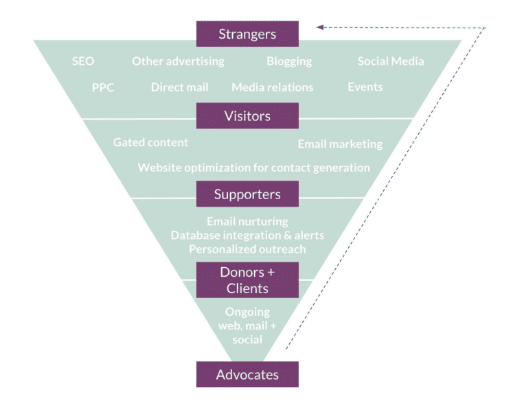The for-profit world commonly uses the phrase “marketing and sales alignment” to refer to the relationship between the two departments, where marketing is responsible for lead generation and nurturing and sales is responsible for closing business. According to Salesforce:
The new reality is that sales and marketing are continuously and increasingly integrated. Marketing needs to know more about sales, sales needs to know more about marketing, and we all need to know more about our customers.
While the concept of marketing and sales alignment is critical in the for-profit world, marketing and fundraising alignment is just as critical in the social sector as donors are more mobile-forward and socially connected than ever.
[bctt tweet=”While the concept of marketing and sales alignment is critical in the for-profit world, marketing and fundraising alignment is just as critical in the social sector as donors are more mobile-forward and socially connected than ever.” username=”ProsperStrat”]The role of marketing versus the role of fundraising
Marketing and fundraising serve two different functions, but they are inextricably linked. The success of one leads to the success of the other. In fact, so much so, that many nonprofits put the same person in charge of both marketing and fundraising. While I don’t think this is the best approach, sometimes it’s the only option. So whether your marketing and fundraising fall to one person or two different people or departments, your marketing and fundraising plans should be separate but closely aligned.
To create this alignment, both your marketing and fundraising plans should stem from your organization’s strategic plan. There will be initiatives in your strategic plan that are best addressed by marketing, those that are best addressed by development and those where both functions need to work together. Once your organization’s strategic plan is in place, you should set your fundraising goals and your fundraising plan. Then, you should create your marketing plan to account for both the goals laid out in the strategic plan and the goals laid out in your fundraising plan.
Creating marketing and fundraising alignment
During your marketing and fundraising planning processes, marketing and development should work together to define how marketing interacts with each one of your organization’s contacts. In the following chart, you can see the various touchpoints marketing might have with individuals based on their relationship with your organization.
When a contact transitions from a supporter to a donor, it doesn’t mean that marketing no longer communicates with these individuals, however the nature of the communication is likely to change.
What will guide this change in communication? Your donor segments, which should be defined in your fundraising plan. These might include groups like major donors, corporate donors, foundations and individual donors.
With your donor segments in mind, marketing leaders and development leaders need to work together to determine how communications to these various groups should be handled. For example, marketing may have little to no interaction with major donors because your development team wants to make personalized outreach. On the other hand, marketing may handle all regular communication, including appeals, for individual donors using tactics like email, direct mail and social media.
While marketing and fundraising alignment starts with the alignment of plans, it should be supported by weekly meetings between the marketing and development teams to review each department’s metrics, and share insights, priorities and upcoming activities.
